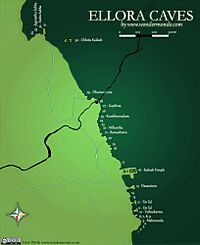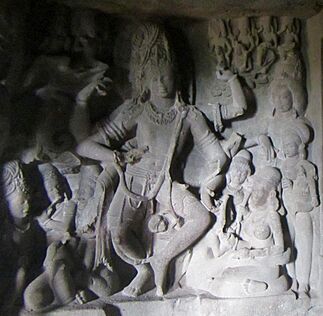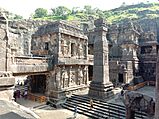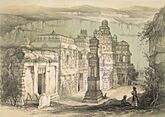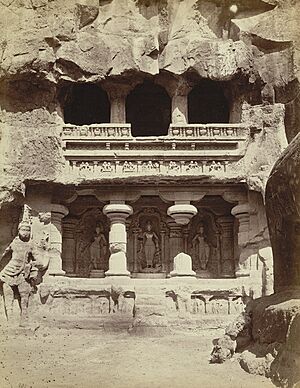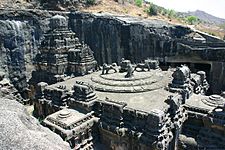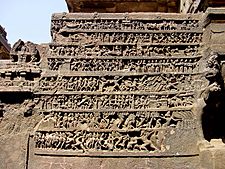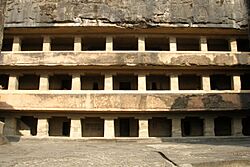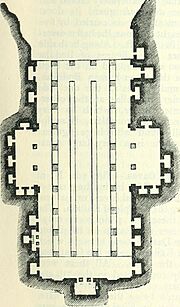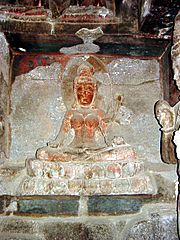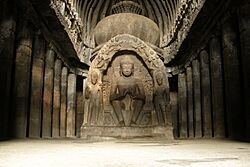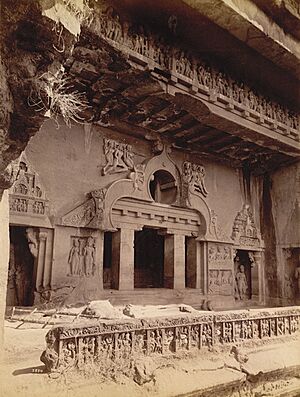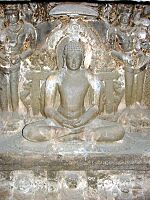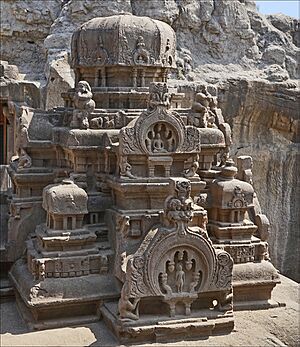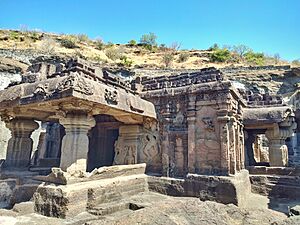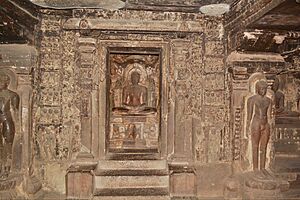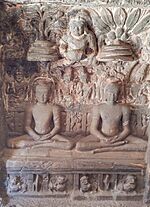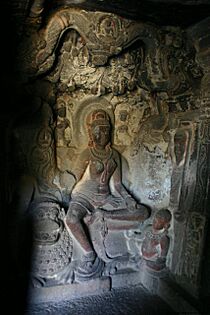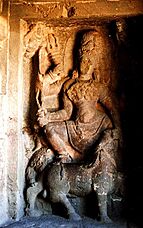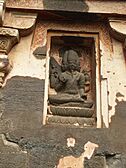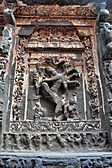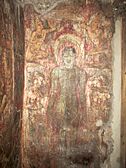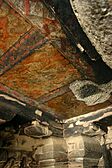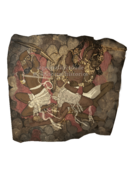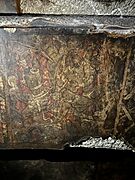Ellora Caves facts for kids
Quick facts for kids Ellora Caves |
|
|---|---|
| Lua error in Module:Location_map at line 420: attempt to index field 'wikibase' (a nil value). | |
| Type | Monolithic caves |
| Location | Chatrapati Sambhaji Nagar, Maharashtra, India |
| Area | Indian |
| Type | Cultural |
| Criteria | i, iii, vi |
| Designated | 1983 (12th session) |
| Reference no. | 243 |
| UNESCO Region | Asia-Pacific |
The Ellora Caves (pronounced Eh-LOH-rah) are a UNESCO World Heritage Site located in the Chhatrapati Sambhaji Nagar district of Maharashtra, India. These amazing caves are one of the largest rock-cut temple complexes in the world. They feature ancient artwork from around 600 to 1000 CE. You'll find Hindu, Buddhist, and Jain "caves" here.
Ellora is a top example of Indian rock-cut architecture. Many of these aren't true caves, but huge structures carved right out of the rock! Cave 16 is home to the largest single rock carving in the world, the Kailash temple. This temple looks like a chariot and is dedicated to the Hindu god Shiva. The Kailash temple also has sculptures of many Hindu gods and goddesses. It even shows scenes from two major Hindu stories.
There are over 100 caves at Ellora, all carved from the basalt cliffs of the Charanandri Hills. Thirty-four of these caves are open to visitors. They include 17 Hindu caves (13–29), 12 Buddhist caves (1–12), and 5 Jain caves (30–34). Each group shows the gods and stories popular in ancient India. They also include monasteries for each religion. The caves were built close together, showing how different religions lived in harmony long ago. The Rashtrakuta dynasty (753-982 CE) built many Hindu and Buddhist caves. The Yadava dynasty (around 1187–1317) built several Jain caves. Rich people, traders, and royals helped pay for these incredible monuments.
The caves were used as temples and resting places for travelers. Because they were on an old trade route, Ellora also became an important business center. It's about 29 kilometers (18 miles) northwest of Aurangabad and 300 kilometers (186 miles) east-northeast of Mumbai. Today, the Ellora Caves and the nearby Ajanta Caves are popular tourist spots. They are protected by the Archaeological Survey of India (ASI).
Contents
What's in a Name?
Ellora is also called Verul or Elura. These are shorter versions of its old name, Elloorpuram. An ancient writing from 812 CE mentions "this great building" at Elapura, referring to the Kailasa temple. In India, each cave has a name with a suffix like Guha (Sanskrit) or Lena / Leni (Marathi), which means "cave."
Some people think the name comes from Ilvalapuram. This name is after the asura (a type of powerful being) Ilvala. He ruled this area and was defeated by a wise man named Agastya.
Where are the Ellora Caves?
The Ellora Caves are in Maharashtra, India. They are about 29 kilometers (18 miles) northwest of Sambhaji Nagar city. Mumbai is about 300 kilometers (186 miles) away to the east-northeast. The Ajanta Caves are about 100 kilometers (62 miles) to the west. The Grishneshwar Temple is very close, just 2.3 kilometers (1.42 miles) away.
Ellora is in a flat, rocky area of the Western Ghats. Long ago, volcanoes created many layers of basalt rock here. This rock is known as the Deccan Traps. The volcanic activity happened during the Cretaceous period. This created a tall, vertical cliff. This made it easy for ancient builders to reach different rock layers. They could choose the best basalt for detailed carvings.
When Were the Caves Built?

People have studied the building of Ellora since British rule. It's hard to know the exact order of construction. This is because the styles of the Buddhist, Hindu, and Jain caves often overlap. Experts usually agree on three main building periods:
- An early Hindu period (around 550 to 600 CE).
- A Buddhist period (around 600 to 730 CE).
- A later Hindu and Jain period (around 730 to 950 CE).
Some of the earliest caves, like Cave 29 (Hindu), were likely built by the Kalachuri dynasty. The Buddhist caves were probably built by the Chalukya dynasty. The later Hindu caves and early Jain caves were built by the Rashtrakuta dynasty. The last Jain caves were built by the Yadava dynasty.
The Hindu Caves: Caves 13–29
The Hindu caves were built in two stages. This happened during the Kalachuri period, from the mid-6th to the late 8th century. Nine cave temples were carved in the early 6th century. Four more caves (17–29) followed. Caves 14, 15, and 16 were built later, during the Rashtrakuta period. These are from the 8th to 10th centuries. King Krishna I helped finish these caves in the 8th century.
Early Hindu Temples: Dhumar Lena, Cave 29
Building the early Hindu caves started before any Buddhist or Jain caves. These early caves were mostly for the Hindu god Shiva. But they also honored other gods and goddesses. A common feature was a rock-cut linga-yoni (a symbol of Shiva and Shakti). This was in the center of the shrine, with space to walk around it.
Cave 29, also called Dhumar Lena, is one of the oldest and largest caves at Ellora. Its design includes a natural waterfall called the "Vale Ganga." This waterfall is visible from a carved balcony. It looks like it's "falling over great Shiva's brow" during monsoon season. The carvings here are larger than life.
Rameshwar Temple: Cave 21
Cave 21, known as Rameshwar Lena, is another early cave. It was built by the Kalachuri dynasty. This cave was finished before the Rashtrakuta dynasty took over.
The cave has unique carvings. These include scenes of goddess Parvati trying to win Shiva's love. You can see Parvati and Shiva relaxing, their wedding, and Shiva dancing. The cave also features the Sapta Matrika, seven mother goddesses. They are flanked by Ganesha and Shiva. Other goddesses like Durga are also inside. At the entrance, large sculptures of the goddesses Ganga and Yamuna stand. They represent two important Himalayan rivers.
The cave's layout is very balanced. It follows the mandapa square principle. The Shiva linga in the main shrine is equally far from the Ganga and Yamuna statues. This forms an equilateral triangle. This design likely shows the connection between male and female energies in Hindu theology.
The Kailāśa Temple: Cave 16
Cave 16, called the Kailasa temple, is very special. It's famous for its huge size and amazing design. It was carved entirely from a single rock!
The Kailasha temple is inspired by Mount Kailash, the home of Shiva. It looks like other Hindu temples. It has a gateway, a large hall, and a main temple with many smaller shrines. There's also a space to walk around the main shrine. The garbha-grihya (holy inner room) holds the linga-yoni. The roof looks like Mount Kailash. All of this is carved from one giant rock. Other shrines carved from the same rock honor Ganga, Yamuna, Saraswati, and the ten avatars of Vishnu. You'll also see Vedic gods like Indra and Surya. Plus, there are deities like Ganesha, Ardhanarishvara (half Shiva, half Parvati), and Durga. The temple's lower level has many carvings of Shiva, Vishnu, and Shakti. A notable set shows twelve stories from the childhood of Krishna.
This temple is a freestanding, multi-level complex. It covers an area twice the size of the Parthenon in Athens. It's believed that workers removed three million cubic feet of stone. That's about 200,000 tonnes of rock!
The Rashtrakuta king Krishna I (756–773 CE) is credited with building the temple. But some parts show Pallava architectural styles. The main courtyard is 82 meters (269 feet) long and 46 meters (151 feet) wide. It stands 30 meters (98 feet) high. The entrance has a low gopuram (tower). The central shrine has a flat-roofed mandapa (hall) with 16 pillars. It also has a Dravidian shikhara (spire). A statue of Shiva's sacred bull, Nandi, stands in front. Two walls in the main temple show carvings from the Mahabharata and the Ramayana.
The Kailasha temple is a truly amazing example of ancient Indian temple building. Many call it a "wonder of the world" among rock-cut monuments.
The Dashavatara: Cave 15
The Dashavatara temple, or Cave 15, is another important cave. It was finished after Cave 14 (Ravan ki Khai, Hindu). Cave 15 has a layout similar to Buddhist Caves 11 and 12. This suggests it might have been planned as a Buddhist cave. However, it has Hindu features, like a Nrtya Mandapa (dance pavilion) at its entrance. Hindu images have been found in Buddhist Cave 11. Also, many Hindu gods appear in Buddhist caves in this area. This mix of designs might mean the same builders worked on both types of caves. Or, a planned Buddhist cave might have been changed into a Hindu one.
Some experts believe all the Buddhist caves at Ellora were built in an area that was already a Hindu pilgrimage site. Also, most Ellora caves don't have names of the people who paid for them. Only Hindu dynasties have left records of building the Buddhist caves. So, the original purpose of these caves is still a bit of a mystery.
The Hindu temple in Cave 15 has an open court. It has a freestanding mandapa in the middle. At the back is a two-story temple carved into the rock. Large carvings on the upper floor show many themes. These include the ten avatars of Vishnu. An important inscription by Dantidurga is on the back wall. This helps date the temple. One of the best carvings shows Vishnu as a man-lion (Narasimha) killing Hiranyakashipu. Other carvings in Cave 15 include Shiva and Parvati, Durga, and Nandi. The carvings are often in pairs. This shows "cooperative but also opposing energy."
Other Hindu Caves
Other important Hindu caves are the Ravan ki Khai (Cave 14) and the Nilkantha (Cave 22). Both have many sculptures. Cave 25 has a carving of Surya (the sun god) on its ceiling.
The Buddhist Caves: Caves 1–12
These caves are on the southern side of Ellora. They were built between 630 and 700 CE, or 600–730 CE. People once thought Buddhist caves were built first. But now, most scholars believe Hindu caves were built before them. The earliest Buddhist cave is Cave 6. Caves 11 and 12, also called Do Thal and Tin Thal, were built last.
Eleven of the twelve Buddhist caves are viharas. These are monasteries with prayer halls. They are large, multi-story buildings carved into the mountain. They include living areas, sleeping rooms, kitchens, and other spaces. The monastery caves have shrines with carvings of Gautama Buddha, bodhisattvas, and saints. Some carvings are made to look like wood.
Caves 5, 10, 11, and 12 are important Buddhist caves. Cave 5 is unique. It's a hall with parallel benches in the center and a Buddha statue at the back. This design is rare in India. Caves 1 to 9 are all monasteries. Cave 10, the Vīśvakarmā Cave, is a major Buddhist prayer hall.
Caves 11 and 12 are three-story Mahayana monastery caves. They have idols, mandalas carved into the walls, and many goddesses. They also show Bodhisattva-related art. This suggests that Vajrayana Buddhism was well-known in South Asia by the 8th century CE.
The Vishvakarma Cave
Cave 10 is a special Buddhist cave. It's a chaitya (worship hall) called the 'Vishvakarma cave'. It was built around 650 CE. It's also known as the "Carpenter's Cave." This is because the rock carvings look like wooden beams. Beyond its multi-story entrance is a large hall with a stupa (a dome-shaped structure). This hall is also called a chaitya-griha (prayer house). In the center of this cave is a 15-foot statue of Buddha. He is seated in a preaching pose.
Cave 10 combines a vihara (monastery) with a chapel-like worship hall. It has eight smaller rooms and a front porch. It's the only dedicated chaitya griha among the Buddhist caves. It's built like Caves 19 and 26 at Ajanta. Cave 10 also has an arched window called a gavaksha. It connects to Cave 9 of Ellora.
The main hall of the Visvakarma cave is curved at one end. It has a central nave and side aisles. These are separated by 28 octagonal pillars. At the curved end is a stupa with a large seated Buddha statue. A big Bodhi tree is carved behind him. The hall has a vaulted roof. The ribs on the roof are carved to look like wooden ones. Carvings above the pillars show Naga queens. Other detailed artwork shows entertainers, dancers, and musicians.
The front of the prayer hall is a rock-cut courtyard. You enter it by climbing steps. The cave's entrance has carved decorations. These include Indian designs like apsaras (celestial dancers) and meditating monks. The various levels of Cave 10 also have statues of gods and goddesses. These include Maitreya, Tara, and Avalokitesvara.
The Jain Caves: Caves 30–34
At the north end of Ellora are five Jain caves. They belong to the Digambara group of Jainism. These caves were carved in the 9th and early 10th centuries. They are smaller than the Buddhist and Hindu caves. But they have very detailed carvings. They share some design ideas with the later Hindu caves. These include pillared porches and balanced halls. However, Jain temples focus on showing the twenty-four Jinas. These are spiritual leaders who found freedom from rebirth. The Jain temples also have carvings of gods, goddesses, and human followers.
According to scholar Jose Pereira, the five caves are actually 23 separate carvings. These were made over different times. He believes the Jain caves started in the late 8th century. Building continued into the 13th century. It stopped when the Delhi Sultanate took over the region. This is supported by writings from 1235 CE. These writings say a donor made Charanadri a holy place for Jains.
Important Jain shrines include the Chhota Kailash (Cave 30), the Indra Sabha (Cave 32), and the Jagannath Sabha (Cave 33). Cave 31 is an unfinished hall. Cave 34 is a small cave. You can reach it through an opening in Cave 33.
The Jain caves have some of the earliest images of Samavasarana. This is a special hall where a Tirthankara preaches after gaining perfect knowledge. Another interesting feature is the pairing of sacred figures. Parsvanatha and Bahubali appear together 19 times. Other important artworks include Sarasvati, Sri, and Hanuman.
Chhota Kailasha: Cave 30
The Chhota Kailasha means "little Kailasha." It's named this because its carvings are similar to the Kailasha temple. This temple was likely built in the early 9th century. It has two large carvings of dancing Indra. One has eight arms, the other twelve. Both are decorated with jewelry and crowns. Indra's arms show different hand poses, like the dancing Shiva art in nearby Hindu caves. But other details show it's Indra, not Shiva. The Indra panels also show other gods, musicians, and dancers.
Some art historians wonder if music and dance were part of Jainism in the 9th century. Jainism often focuses on quiet meditation. One idea is that Cave 30 might have been a Hindu temple first, then changed into a Jain one. However, others suggest the joyful art shows the Samavasarana idea in Jainism.
The mix of Jain and Hindu carvings can be confusing. The Hindu Mahabharata describes Indra's home as a paradise with heroes and artists. This idea is seen in Cave 30, like in the Hindu caves. But closer to the center, the symbols are more Jain. There are more meditating figures and Jinas. This is where Jain followers would perform their worship.
Cave 31
Cave 31 has four pillars, a small shrine, and several carvings. It was not finished. Carvings of Parshvanatha are on the left wall. He is guarded by yaksha Dharanendra with his 7 hoods. Gommateshvara is on the right wall. Inside the shrine is a statue of Vardhamana Mahavir Swami. He is seated in a padmasan position on a lion-throne. A wheel is carved on the throne. The yaksha Matanga on an elephant is on the left side of the shrine. The yakshi Siddhaiki is on the right. She is seated on a lion with a child.
The Indra Sabha: Cave 32

The Indra Sabha (Cave 32) was carved in the 9th century. It's a two-story cave with a single-rock shrine in its courtyard. In the 1800s, historians thought the Jain Yaksas were images of Indra. This led to the temple being wrongly called "Indra Sabha." Indra is important in all three religions. In Jainism, he is a king of the heavens. He is also the main builder of the celestial assembly hall.
The Indra Sabha Jain temple is historically important. It shows that the Jain community actively worshipped here. There are layers of deposits and old writings that prove this. Rituals were held on the upper level, where the artwork was central.
Many carvings decorate the temple. These include lotus flowers on the ceiling. On the upper level, there's a carving of Ambika. She is the yakshini (female nature deity) of Neminath. She sits on her lion under a mango tree. In the center of the shrine is Sarvatobhadra. Here, four Jain Tirthankaras are placed facing the main directions. These are Rshibha, Neminatha, Parsvanatha, and Mahavira. This creates a special place for worship.
The Jagannatha Sabha: Cave 33
The Jagannatha Sabha (Cave 33) is the second-largest Jain cave at Ellora. Writings on its pillars show it dates to the 9th century. It's a two-story cave with twelve huge pillars. Elephant heads stick out towards a porch. All of this is carved from a single rock. The hall has two large square pillars in front. Four more are in the middle. The main inner hall has fluted pillars. These are carved with detailed tops, ridges, and brackets. Inside, the main statues are of Parshvanatha and Mahavira. They are the last two Tirthankaras in Jainism.
Cave 34
Some writings in Cave 34 are still a mystery. But they were likely made between 800 and 850 CE. Other writings, like one by Sri Nagavarma, are thought to be from the 9th or 10th century.
This cave has a large seated Parshvanatha Jina. He has four camara (fly-whisk) attendants. Two seem to come from behind his throne. Like many other Jain caves, this one also has a large pair of yaksa-yaksi (nature deities) near the Jina. At the back of the cave is a bearded figure. He holds a bowl with round offerings. These look like pindas (rice balls) or laddus (sweet treats). This might show a Jain worship ceremony. The Parshvanatha in the cave is paired with a standing Gommateshvara. Other carvings show musicians playing horns, drums, and cymbals. A special feature is a giant, open lotus carved on the ceiling. This is found in only one other Jain cave and one Hindu cave (Cave 25) at Ellora. The lotus on the ceiling shows that the temple is a holy place.
Rock-Carved Image of Lord Parshvanath
On the hill northeast of the main caves is a Jain temple. It has a 16-foot rock-carved image of Lord Parshvanath. This carving is from the Rashtrakuta period. An inscription dates it to 1234 A.D. The image is well-preserved. It is flanked by Dharaıendra and Padmavati. The inscription calls the site Charana Hill, a holy place. People still worship here, so it is not protected by the ASI. You have to climb 600 steps to reach it. A Jain Gurukul (school) in the village manages it.
Visitors and Changes Over Time
People have visited these caves regularly for centuries. They were close to a trade route. For example, Buddhist monks often visited Ellora in the 9th and 10th centuries. A traveler from Baghdad in the 10th century called it "Aladra." He described it as a great temple and pilgrimage site. In 1352 CE, records mention Ala-ud-Din Bahman Shah camping there. Other visitors also wrote about Ellora. Some accounts were not fully accurate. For example, Niccolao Manucci, a Venetian traveler, thought the caves were made by "the ancient Chinese."
Ellora was well-known during the Mughal times. Emperor Aurangzeb and other nobles would have picnics there. A courtier of Aurangzeb said people visited all year, especially during the monsoon. He noted "many kinds of images with lifelike forms" carved on walls and ceilings. But he also said the monuments were "in a state of desolation."
An old Marathi text from the late 13th century says that Ellora was no longer actively used then. Records show that Deogiri, a city near Ellora, was attacked around 1294 CE. It then fell to the Delhi Sultanate. There is evidence that work in the Jain caves continued into the 13th century. But Jain religious activity stopped after the region came under new rule in the late 13th century.
The Buddhist, Hindu, and Jain monuments at Ellora show some damage. This is especially true for the statues. However, detailed carvings on pillars and natural objects on walls are still intact. This damage to statues likely happened between the 15th and 17th centuries. During this time, the region saw conflicts that led to the damage of religious images. Some people at the time were sad about this damage. They saw it as a "violation of beauty."
Ellora Inscriptions
Several inscriptions at Ellora date from the 6th century onwards. The most famous is by Rashtrakuta king Dantidurga (around 753–757 CE). It's on the back wall of Cave 15. It says he prayed at that temple. Jagannatha Sabha (Jain cave 33) has three inscriptions. These give the names of monks and donors. A Parshvanath temple on the hill has a 1247 CE inscription. It names a donor from Vardhanapura.
The Great Kailasa temple (Cave 16) is linked to Krishna I (around 757–783 CE). He was Dantidurga's successor and uncle. A copper plate found in Gujarat says a great building was made on a hill at Elapura (Ellora) by Krishnaraja:
...a temple of wonderful structure was built on the hill at Elapura. Seeing it, the best of gods in their celestial cars, struck with wonder, say "This temple of Shiva is self-existent; such beauty is not seen in anything made by art (...). The architect who built it (...) was himself suddenly struck with wonder, saying "Oh, how did I build it!"
Painted Carvings and Paintings
The carvings at Ellora were once brightly painted. The rock was covered with a lime plaster, which was then painted. Some of this plaster and paint still remain today.
- A digital restoration of an Ellora mural
Images for kids
See also
 In Spanish: Ellora para niños
In Spanish: Ellora para niños


